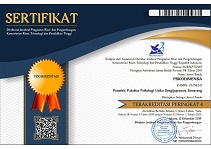Smartphones Trigger Depression: A Review of Meta Analysis
Abstract
Keywords
Full Text:
PDFReferences
Aker, S., Sahin, M. K., Sezgin, S., & Oguz, G. (2017). Psychosocial Factors Affecting Smartphone Addiction in University Students. Journal of Addictions Nursing, 28(4), 215-219.
Akin, A., & Iskender, M. (2011). Internet Addiction and Depression, Anxiety and Stress. International Online Journal of Educational Sciences, 3(1), 138-148.
Aljomaa, S. S., Mohammad, M. F., Albursan, I. S., Bakhiet, S. F., & Abduljabbar, A. S. (2016). Smartphone addiction among university students in the light of some variables. Computers in Human Behavior, 61, 155-164. doi:10.1016/j.chb.2016.03.041
Alliance, I. I. (2018). Research Peek of the Week: Smartphone Users in the US Expected to Reach Over 270 Million by 2022. Retrieved from https://internetinnovation.org/general/research-peek-of-the-week-smartphone-users-in-the-us-expected-to-reach-over-270-million-by-2020/
American Psychiatric Association. (2013). Diagnostic And Statistical Manual of Mental Disorder Edition “DSM-5”. Washinton DC: American Psychiatric Publishing.
Bianchi, A., & Phillips, J. G. (2005). Psychological predictors of mobile phone use. Cyberpsychology&Behavior, 8, 39-51. doi:10.1089/cpb.2005.8.39
Boumosleh, J. M., & Jaalouk, D. (2017). Depression, anxiety, and smartphone-addiction in universtiy students- A cross sectional study. PLoS ONE, 12(8), 1-14. doi:10.1371/journal.pone.0182239
Cagan, O., Unsal, A., & Celik, N. (2014). Evaluation of college students'the level of addiction to cellular phone and investigation on the relationsship between the addiction and the level of depression. Procedia - Social and Behavioral Sciences, 114, 831-839.
Demirci, K., Akgonul, M., & Akpinar, A. (2015). Relationship of smartphone use severity with sleep quality, depression, and anxiety in university students. Journal of Behavioral Addictions, 4(2), 85-92. doi:10.1556/2006.4.2015.010
Duke, E., & Montag, C. (2017). Smartphone addiction, daily interruptions and self-reported productivity. Addictive Behavior Report, 6, 90-95. doi:10.1016/j.abrep.2017.07.002
Darcin, A.E., Kose, S., Noyan, C.O., Nurmedov, S., Yilmaz, O., & Dilbaz, N. (2016). Smartphone addiction and its relationship with social anxiety and loneliness. Behaviour and Information Technology, 35(7), 520-525. doi:10.1080/0144929X.2016.1158319
Elhai, J. D., Dvorak, R. D., Levine, J. C., & Hall, B. J. (2017). Problematic smartphone use: a conceptual overview and systematic review of relations with anxiety and depression psychopathology. J Affect Disord, 207, 251-259. doi:10.1016/j.jad.2016.08.030
Elhai, J. D., Levine, J. C., Dvorak, R. D., & Hall, B. J. (2016). Fear of missing out, need for touch, anxiety and depression are related to problematic smartphone use. Computers in Human Behavior, 63, 500-516.
Farrah, M. A., & Dawood, A. K. (2018). Using mobile phone applications in teaching and learning process. International Journal of Research in English Education, 3(2), 48-68.
Ghasempour, A., & Mahmoodi-Aghdam, M. (2015). The Role of Depression and Attachment Styles in Predicting Students’ Addiction to Cell Phones. Addict Health, 7(3-4), 192-197.
Gutiérrez, J. D., Fonseca1, F. R., & Rubio, G. (2016). Cell-Phone Addiction: A Review. Frontiers in Psychiatry, 7(175), 1-15. doi:10.3389/fpsyt.2016.00175
Harwood, J., Dooley, J. J., Scott, A. J., & Joiner, R. (2014). Constantly connected – The effects of smart-devices on mental health. Computers in Human Behavior, 34, 267-272. doi:10.1016/j.chb.2014.02.006
Holst, A. (2018). Smartphones in the U.S. - Statistics & Facts. Retrieved from https://www.statista.com/topics/2711/us-smartphone-market/
Inal, E. E., Demirci, K., Cetinturk, A., Akgonul, M., & Saves, S. (2015). Effects of smartphone overuse on hand function, pinch, strength and the median nerve. Muscle nerve, 52, 183-188.
Ithnain, N., Ghazali, S., & Jaafar, N. (2018). Relationship between smartphone addiction with anxiety and depression among undergraduate students in malaysia. International Journal of Health Sciences & Research, 8(1), 163-171.
Jun, S. (2016). The reciprocal longitudinal relationships between mobile phone addiction and depressive symptoms among Korean adolescents. Computers in Human Behavior, 58, 179-186. doi:10.1016/j.chb.2015.12.061
Kim, H. J., & Kim, J. S. (2015). relationship between smartphone use and subjective musculoskeletal symptoms and university students. J Phys Ther Sci, 27, 575-579.
Kim, J. H., Seo, M., & David, P. (2015). Alleviating depression only to become problematic mobile phone users: Can face-to-face communication be the antidote? Computers in Human Behavior, 51, 440-447. doi:10.1016/j.chb.2015.05.030.
Kim, S. G., Park, J., Kim, H. T., Pan, Z., Lee, Y., & Mclntyre, R. S. (2019). The relationship between smartphone addiction and symptoms of depression, anxiety, and attention-deficit/hyperactivity in South Korean adolescents. Ann Gen Psychiatry, 18(1), 1-8. doi:10.1186/s12991-019-0224-8
Kuhdasht, R. N., Ghayeninejad, Z., & Nastiezaie, N. (2018). The relationship between phone dependency with psychological disorders and academic burnout in students. Journal of Research & Health, 8(2), 189-195.
Kwon, Y. S. (2016). The Influence of Smartphone addiction on depression and communication competence among college students. Indian Journal of Science and Technology, 9(41), 1-8.
Lanaj, K., Johnson, R. E., & Barnes, C. M. (2014). Beginning the workday yet already depleted? Consequences of late-night smartphone use and sleep. Organizational Behavior and Human Decision Processes, 124, 11-23. doi:10.1016/j.obhdp.2014.01.001
Langan, K. (2016). The relationship between smartphone use and the development of mental health issues. (High Diploma). Dublin Business School,
Lemola, S., Glour, N., Brand, S., Kaufmann, J. F., & Grob, A. (2014). Adolescents’ electronic media use at night, sleep disturbance, and depressive symptoms in the smartphone age. J Youth Adolescence, 44(2), 405-418.
Lin, Y. H., Chang, L. R., Lee, Y. H., Tseng, H. W., Kuo, T. B., & Chen, S. H. (2014). Development and validation of the smartphone addiction inventory (SPAI). PloS One, 9(6), e98312. . doi:10.1371/journal.pone.0098312
Park, J., Kim, K., Kim, N., Choi, I., Lee, S., Tak, S., & Yim, J. (2015). A comparison of cervical flexion pain and clinical depression in frequency of smartphone use. International Journal of Bio-Science and Bio-Technology, 7(3), 183-190
Qasim, T., Obeidat, M., & Al-Sharairi, S. (2017). The Effect of Smartphones on Human Health Relative to User’s Addiction: A Study on a Wide Range of Audiences in Jordan. International Scholarly and Scientific Research & Innovation, 11(5), 282-285.
evari, K. (2012). The role of mobile phones in education and instruction of classroom materials. ADVANCES IN EDUCATION, 1(1), 19-22.
Soni, R., Upadhyay, R., & Jain, M. (2017). Prevalence of smart phone addiction, sleep quality and associated behaviour problems in adolescents. International Journal of Research in Medical Sciences, 5(2), 515-519. doi:10.18203/2320-6012.ijrms20170142
Stalin, P., Abraham, S. B., Kanimozhy, K., Prasad, R. V., Singh, Z., & Purty, A. J. (2016). Mobile phone usage and its health effects among adults in a semi-urban area of southern india. Journal of Clinical and Diagnostic Research, 10(1), 14-16. doi:10.7860/JCDR/2016/16576.7074
Suresh, S., Sabanayagam, C., Sita, K., & Shankar, A. (2011). Cell-Phone Use and Self-Reported Hypertension: National Health Interview Survey 2008. Int J Hypertens, 1-7. doi:10.4061/2011/360415
Takao, M., Takahashi, S., & Kitamura, M. (2009). Addictive personality and problematic phone use. Cyberpsychology&Behavior, 12, 501-507. doi:10.1089/cpb.2009.0022
Tan, C., Pamuk, M., & Donder, A. (2013). Loneliness and mobile phone. Procedia- Social and Sciences, 103, 606-611. doi:10.1016/j.sbspro.2013.10.378
Taneja, C. (2014). The psychology of excessive cellular phone use. Delhi Psychiatry Journal, 17, 448-451.
Tangmunkongvorakul, A., Musumari, P. M., Thongpibul, K., Srithanaviboonchai, K., Techasrivichien, T., Suguimoto, S. P., Kihara, M.S., & Kihara, M. (2019). Association of excessive smartphone use with psychological well-being among university students in Chiang Mai, Thailand. PLoS One, 14(1), 1-13. doi:10.1371/journal.pone.0210294
Twenge, J., Martin, G. N., & Campbell, W. K. (2018). Decreases in psychological well-being among American adolescents after 2012 and links to screen time during the rise of smartphone technology. Emotion, 18(6), 765-780. doi:10.1037/emo0000403
Vahedi, Z., & Saiphoo, A. (2018). The association between smartphone use, stress, and anxiety: A meta ‐ analytic review. Stress and Health, 34(1), 1-17. doi:10.1002/smi.2805
Vangeepuram, N., Mayer, V., Fei, K., Rosado, E., Andrade, C., Wright, S., & Horowitz, C. (2018). Smartphone ownership and perspectives on health apps among a vulnerable population in East Harlem, New York. MHealth, 4(31), 1-8. doi:10.21037/mhealth.2018.07.02
Wang, R., Wang, W., Dasliva, A., Huckins, J. F., Kelley, W. M., Heartherton, T. F., & Campbell, A. T. (2018). Tracking depression dynamics in college students using mobile phone and wearable sensing. Proceedings of the ACM on Interactive, Mobile, Wearable and Ubiquitous Technologies, 2(1), 1-26.
DOI: https://doi.org/10.24167/psidim.v19i1.2230
Print ISSN : 1411-6073 | online ISSN : 2579-6321 View My Stats

This work is licensed under a Creative Commons Attribution 4.0 International License.




















